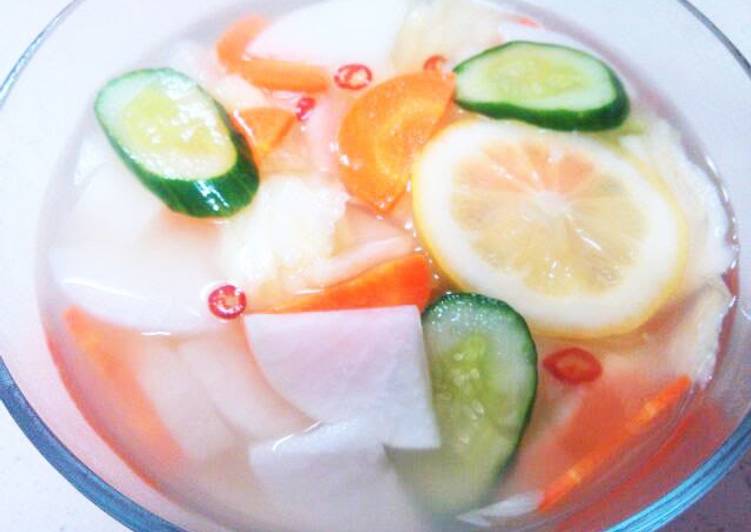Radish and Pear Mul (Water) Kimchi. Finely julienne the garlic and ginger. Salt the vegetables except for the pear and lemon and let sit until they begin to dehydrate. Korean Water Kimchi (mul kimchi 물김치) is traditionally served as part of a Korean meal as banchan (side dish) but recently, especially in more fancy restaurants, they are served almost as apértif - as a way to stimulate your appetite.
 Nabak kimchi is a type of water kimchi that's made with thinly sliced radish squares and other vegetables. Wash the radishes in cold water with a sponge to remove any dirt. Put ⅓ cup sea salt or kosher salt in a large and shallow bowl. You can have Radish and Pear Mul (Water) Kimchi using 13 ingredients and 11 steps. Here is how you cook it.
Nabak kimchi is a type of water kimchi that's made with thinly sliced radish squares and other vegetables. Wash the radishes in cold water with a sponge to remove any dirt. Put ⅓ cup sea salt or kosher salt in a large and shallow bowl. You can have Radish and Pear Mul (Water) Kimchi using 13 ingredients and 11 steps. Here is how you cook it.
Ingredients of Radish and Pear Mul (Water) Kimchi
- You need of cm Daikon (white radish).
- You need of Carrot.
- It's of leaves Cabbage.
- You need of Cucumber.
- You need of Asian pear.
- It's of Lemon.
- Prepare of as many you like Red chili peppers (sliced into rounds).
- It's of Garlic.
- You need of Sliced ginger.
- Prepare of Rock salt (or regular salt).
- Prepare of Sugar.
- Prepare of cm Kombu for dashi stock.
- You need of Mineral water (spring water, etc).
Roll each radish in salt with your hands to coat evenly. Put the salted radish into the glass jar. Nabak Kimchi is a mild water kimchi made with radish, cabbage, minari (mugwort) and sometimes fruits like pear or apple. The kimchi is supposed to be eaten within a short time because it's just not good once it over ripens and really sours - unlike the traditional Baechu Kimchi which can be kept for many months to ever years.
Radish and Pear Mul (Water) Kimchi step by step
- Slice the carrots, cucumbers, and radish into 4-5 mm slices, and chop up the cabbage roughly. Finely julienne the garlic and ginger..
- Prepare 7-8 mm pear slices and 2-3 slices of lemon for fragrance..
- Salt the vegetables except for the pear and lemon and let sit until they begin to dehydrate. The water produced from the vegetables you've salted is their juice, so rather than discarding it, use that too in the brine.
- Combine the chili pepper slices, garlic, ginger, sugar to help the fermentation, lemon, kombu for dashi stock, and mineral water, and mix together well..
- Once you've adjusted the salt level, transfer it to a container and leave at room temperature for about 2 hours to half a day in summer, 2-3 days in spring or fall, or 4-5 days in winter. Then, store it in the refrigerator..
- As it ferments, the color of the vegetables will change and it will become thicker and more acidic. Decide when you want to eat it and enjoy..
- [Mul kimchi juice] The juice, brimming with plant-based lactobacillus, is supposed to be very good for your body. It has about 20 times more lactobacillus as nukazuke pickles..
- [Using leftovers] Tomato mul kimchi using leftover juice https://cookpad.com/us/recipes/153321-using-leftovers-for-tomato-mul-water-kimchi.
- Daikon radish and cucumber mul kimchi https://cookpad.com/us/recipes/153861-daikon-radish-and-cucumber-mul-water-kimchi.
- Quick mul kimchi instant pickles https://cookpad.com/us/recipes/153950-mul-water-kimchi-instant-pickles.
- Mul kimchi with naengmyun noodles is super delicious. https://cookpad.com/us/recipes/152409-koreanchinese-chilled-noodles.
It's also delicious with ingredients like apples, watermelon (the white part), and Japanese parsley. Another common Mul Kimchi (water kimchi) is Dong-chi-mi. Dong-chi-mi is a simpler Mul Kimchi with clear broth and only radish as a main ingredient. Nabak Kimchi is a little more elaborate. It usually includes radish and napa cabbages along with other secondary ingredients like minari (water dropworts), chili peppers, cucumbers and carrots.
Comments
Post a Comment